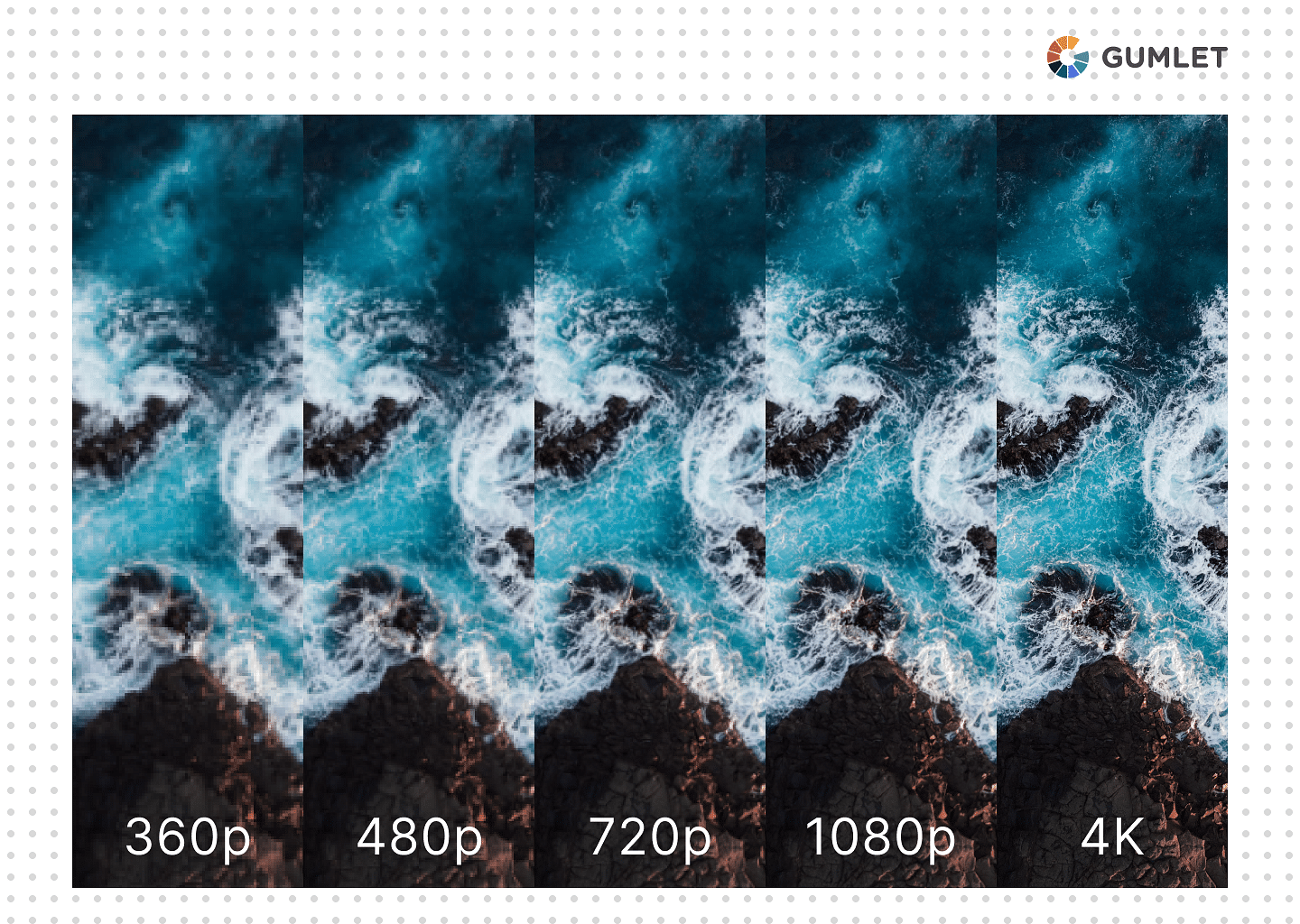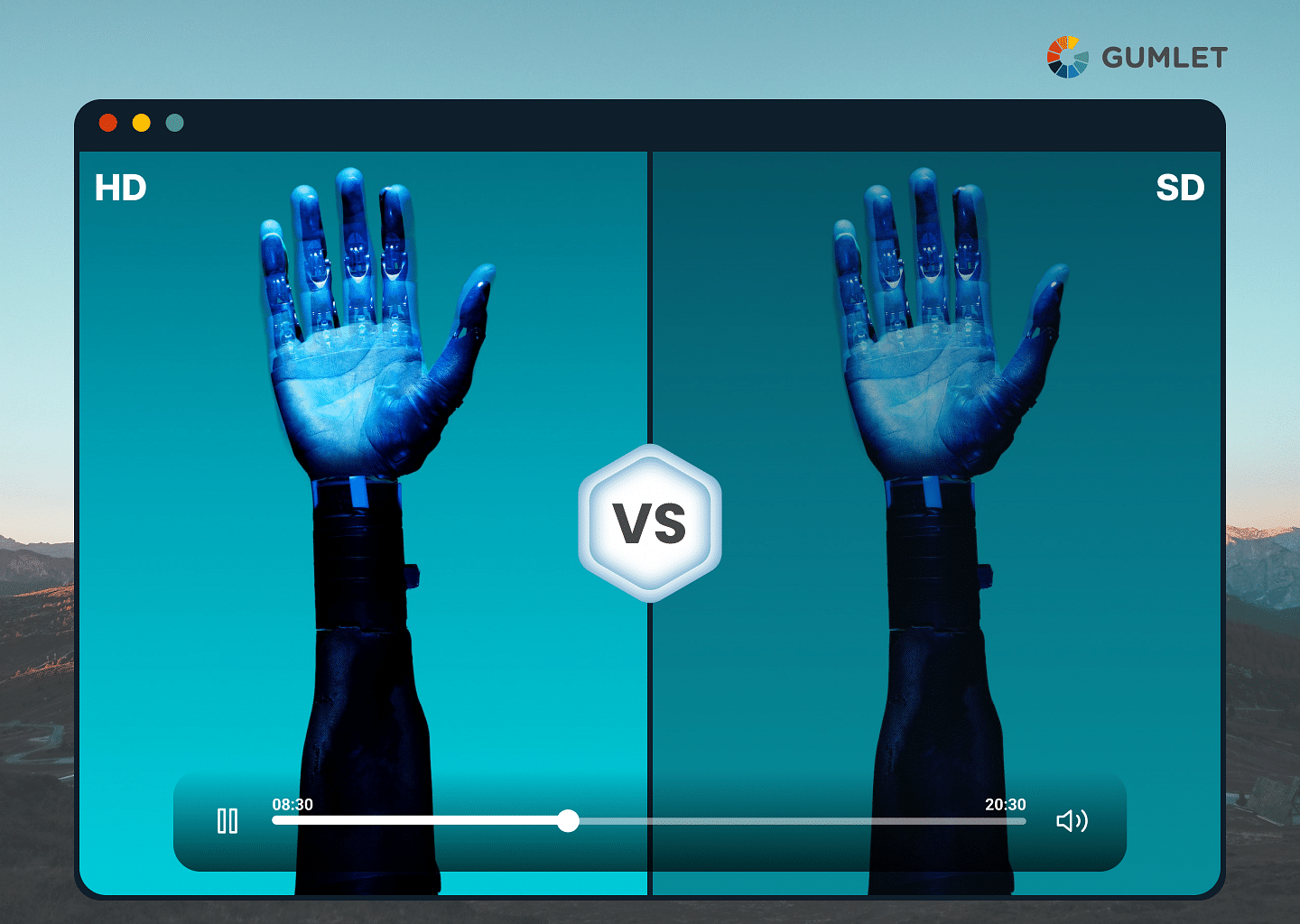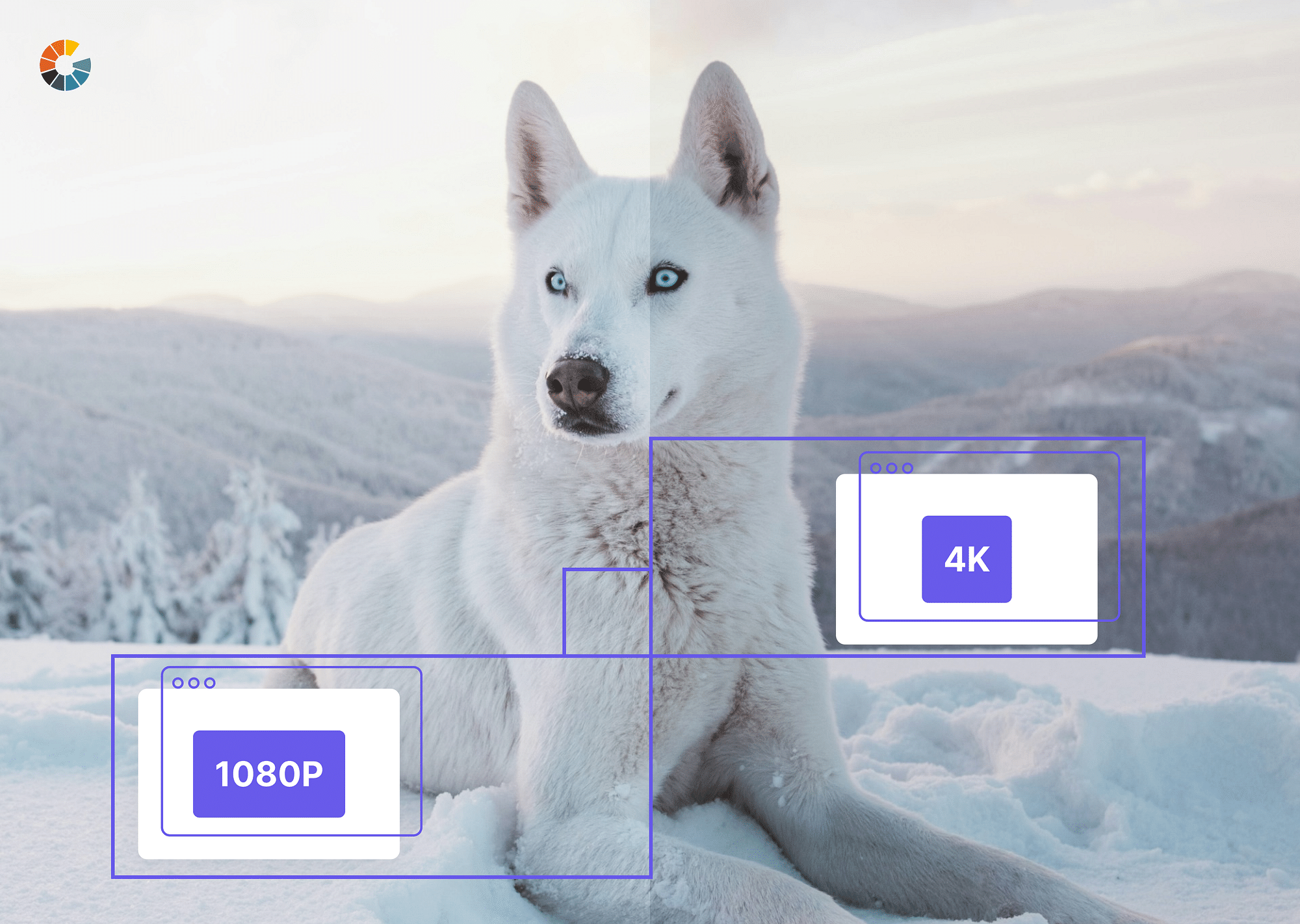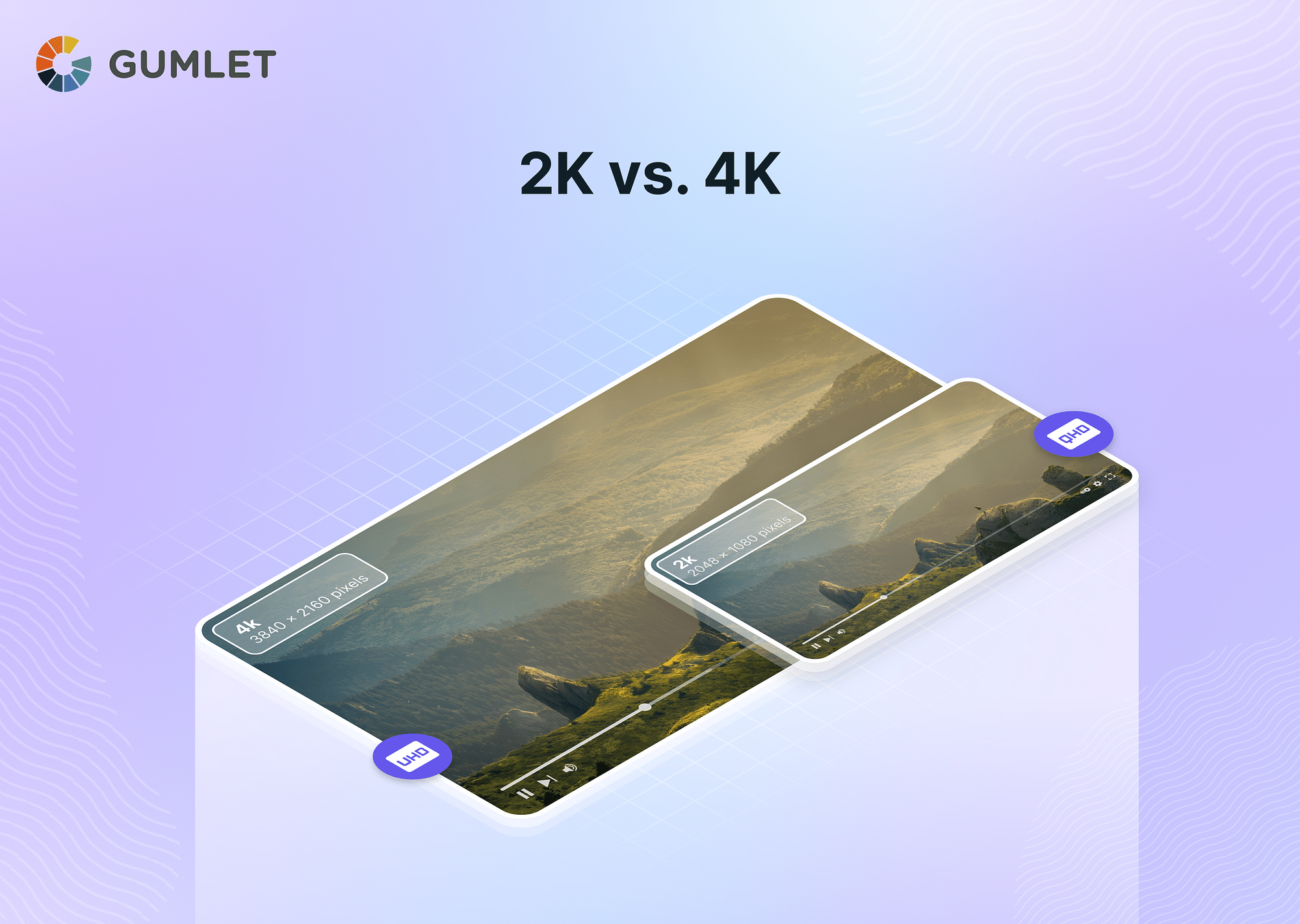What is SD?
As is evident from its name, SD or Standard Definition refers to the standard or base level resolution for streaming—which is 480 pixels in a single image. While it is technically possible to stream at lower resolutions like 144p, 240p, and 360p, SD has been used as an acceptable resolution in the world of live streaming for many years now.
You will find that SD resolution is commonly used in digital cameras, camcorders, and even for some TV broadcasts. For instance, in the American NTSC system, videos with an aspect ratio of 4:3 only have 480i available.
SD videos have lower definitions and tend to be blurry. Depending on the availability of bitrates, SD video quality becomes lower. However, this works as an advantage where less-than-optimal internet connectivity is concerned. You can still reliably stream videos without worrying about buffering and lags.
What is HD?
HD or High Definition typically refers to a resolution of 720 or 1080 pixels. HD is a commonly used format for playback streaming over the internet (for instance, YouTube and other streaming websites). While 720p HD is termed as Standard HD, 1080p HD is referred to as Full HD. The former is best suited for regular live streaming and other video streaming, whereas the latter is more commonly used for higher-quality videos.
When compared to SD resolution, HD provides greater clarity and definition since there is less pixelation in a high-definition video. Pictures in HD have superior color reproduction, plus the faster frame rate ensures smoother video motion.
There is no doubt that the HD resolution offers a smoother and higher definition streaming experience since it has double the number of pixels per frame (1920×1080) when compared to SD video content which has 1280x720. However, this comes at a price.
The HD video format requires significantly higher internet bandwidth, which essentially means that if you don't have high-speed and uninterrupted internet connectivity, you would be at the receiving end of dropouts and stuttered streams.
The other factor to consider is the storage capacity—HD streams demand 4× more data than SD resolution formats. They also require more power which can affect your device's battery life, especially if you are working with outdated editing software or computers.
Video Resolution and Pixels
Video resolution is a major determinant of video quality. It represents the ability of video recording devices to capture the smallest individual element (detail) of an image—which is the pixel. The number of pixels on a screen is equivalent to the resolution of that screen. The higher the number of pixels, the greater the detail and clarity of a picture.
At higher resolutions, you can see the details of the image more clearly and hence, can edit and manipulate it with greater ease.
Among the common video resolutions are 720 x 480, 1280 x 720, 1920 x 1080, and 3480 x 2160.
You will notice that resolutions are often followed by “p” or “i”. For instance, 1080p and 1080i. This essentially refers to how an image is scanned. The “p” refers to “progressive scanning," and “i” refers to an “interlaced" image. While the former produces better video quality, the latter is easier to broadcast.
We'll discuss these terms in later sections. Let's first understand the different types of video quality.
Types of Video Quality
In practice, we have four primary video resolutions: 360p, 480p, 720p, and 1080p — which represent the number of horizontal lines on a video. Anything beyond 1080p is Ultra HD or 2160p or 4k. As is evident, the higher the resolution, the higher will the quality of your video be.

Here's exploring the different types of video resolution formats in detail.
360p - LD - Low Definition
Most of the YouTube content you see will be marked 360p, which indicates the lowest resolution that a video can be streamed in wherein the picture quality is not blurry or unclear. 360p is best suited for smartphones since the smaller screens do not highlight the blurry quality of the video as noticeable when compared to larger screens.
480p - SD - Standard Definition
480p is a widely accepted standard or cut-off for SD videos, wherein the 480 refers to a pixel height of 480 in a single image, and "p" refers to images being transmitted as a progressive scan.
480p provides decent image quality without buffering or lags even if you have a poor internet connection.
720p - HD - High Definition
720p format refers to a resolution of 1280×720 pixels and is commonly used for streaming videos on the internet. It offers a progressive HDTV scanning of 720 horizontal lines/1080 columns at a 16:9 video aspect ratio.
While the difference between 720p and 1080p is not easily noticeable to everyone, you will find that 1080p videos have greater clarity and smoother motion if you pay close attention. 720p or HD resolutions carry 921,600 worth of pixels of information, whereas 1080i or 1080p images have up to 2 million pixels.
Understandably, 720p is less demanding wrt to bandwidth usage and power since it is transmitted as a progressive scan rather than an interlaced image.
1080 and 1080i - FHD - Full High Definition
1080p or ‘Full-HD’ refers to a display resolution of 1920×1080 with 1,920 pixels displayed horizontally and 1,080 pixels displayed vertically across the screen. The "p" is indicative of a progressive scan which is known to produce higher picture quality since each frame is drawn in a single pass down the screen.
1080i, on the other hand, refers to an interlaced scan image wherein the drawing of every frame is done in two passes across the screen. While both 1080p and 1080i are high-definition and have the same resolution and video aspect ratio of 16:9, 1080i takes slightly longer for the human eye to be able to see a complete frame.
1080p images are used for HD broadcasts, Blu-ray players, and Xbox/PlayStation games, whereas 1080i is generally used by TV companies to broadcast interlaced HD images which utilize lesser bandwidth as compared to 1080p.
2160p - 4k or UHD - Ultra High Definition
2160p or 4k or Ultra High Definition (UHD) refers to a display resolution of 3,840 x 2,160, which is approximately four times the full HD resolution of 1080. 2160 is a UHD resolution represents 2160 pixels across the shorter side of the screen, and the "p" indicates a progressive scan or non-interlaced image.
UHD is oft-used as an alternative name for 4k even though it falls slightly short of a "true" 4K resolution.
UHD image is relatively smoother and carries more detail than a full HD image. If you pay close attention, you'll find that the 1080p image is blurry around the edges, and written text is not as clear as on a 2160p image.
Beyond 4k
Further in advanced display technology, we have 8K, which refers to a display resolution format of 7680 x 4320 i.e., 4 times a UHD resolution (4k) and 16 times a full HD resolution (1080).
What makes 8k superior is that it essentially "erases" the pixelation appearance altogether, making an image "pixel-less." This results in an unprecedented amount of detail across the screen and finest picture quality imaginable.
The bandwidth, connectivity, and transfer speed configurations of 8K are significantly higher and would require TVs and other devices to be upgraded for practical usability. Not to mention, video content creators are yet to produce 8k content on a larger scale for broadcasters to adopt 8k streaming resolutions.
SD vs HD: What’s the difference between SD and HD streaming?
By now, you should have a good understanding of the SD vs HD resolution. To put it simply, HD packs superior quality but demands more bandwidth. On the other hand, SD requires less bandwidth, but this also means lower picture quality.
Here's a discussion of their differences in brief:
Video Quality
SD is associated with a lower-quality streaming experience wherein the maximum resolution is 480p. Even though 480p carries more detail and information than a 360p, 240p, or 144p image, it isn't the best option if you are looking for a top-notch streaming experience. HD streaming clearly wins here by ensuring superior image quality, better colors, clarity, detail, and definition. For this reason, it is worth making the extra investment and opting for HD streaming.
Bandwidth Consumption
As is understood, HD streaming requires more bandwidth since you need to stream at a higher bitrate. To give you an idea of where HD vs SD streaming is concerned, you require an internet speed of roughly 25 Mbps and higher to stream 1080p HD videos, at least 10 Mbps for 720p videos, and 5 Mbps for 480p video.
If your target audience is likely to have notoriously poor internet speeds, you don't have much of a choice. However, SD is likely to fizzle out over the next few years as mobile devices and video streaming technology are progressively moving beyond the SD norms.
Video File Size
Higher resolution also translates to bigger file size, greater storage capacity, and processing power requirements. This could be a disadvantage for you if you are still working with older, low-capacity devices and outdated technology.
Which One You Should Choose?
Coming to the HD vs SD debate and which you should choose for your streams, the short answer would be to go for the higher resolution. However, it's not that simple.
In the majority of cases, whether you should choose SD or HD will depend on the bandwidth available to you. If you are expecting connectivity issues, lower speed, and network availability, you should opt for SD streaming. SD is the more viable option where affordability and convenience are concerned.
On the other hand, HD streaming is typically the best option if you are streaming to an audience that has access to a stable internet connection.
Fortunately, Gumlet offers a cutting-edge streaming platform that automatically optimizes video quality based on the availability of bandwidth and processing resources. It also allows viewers to choose their desired video resolution and override default settings if need be.
As a live streamer or video broadcaster, you are better off focusing on your content rather than the streaming technicalities, which differ from platform to platform. So, make it a point to leverage streaming software that has the ability to adjust video quality based on the available bit rates.
Conclusion
Now that you are aware of the nuanced differences between HD and SD resolution formats, you can make an informed choice for your different video streaming requirements. It's always recommended to experiment with multiple formats to get better clarity on the advantages and disadvantages of HD and SD wrt to your projects.
FAQs
- SD or HD: Which is better for me?
HD streams are known for higher quality video. However, they use up significantly more data and tend to be expensive. So, if affordability and bandwidth usage is a concern, it is recommended that you go for SD streaming. If you have the budget for HD streaming, by all means, go ahead with the HD format.
2. Is SD stream faster than HD?
SD is the standard definition at which viewers can comfortably stream videos despite a poor internet connection. It requires less bandwidth and storage capacity. However, HD streams have higher picture quality and detail, which results in a better streaming experience. If you can afford an upload speed of 2.5 Mbps or higher, it is recommended that you go with 720p.
3. What is the highest video quality?
The highest video quality in use today is 4K or Ultra-HD or ultra-high-definition. It refers to a resolution of 3840 x 2160 pixels across a widescreen video aspect ratio and packs significantly greater detail and image quality when compared to lower-res videos. There are video resolution formats beyond 4k, such as 8k or 16k or higher. However, they are yet to see widespread adoption due to lack of practice applications.



